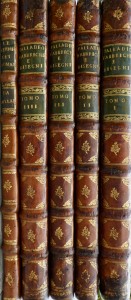
Jonathan Clark Fine Books
Art and Architecture
BERTOTTI-SCAMOZZI, Ottavio.
Le Fabbriche e i Disegni di Andrea Palladio Raccolti Ed illustrati Da Ottavio Bertotti Scamozzi Opera Divisa in Quattro Tomi con Tavole in rame rappresentanti le Piante, I Prospetti, e gli Spaccati. Con La Traduzione Francese. Tomo Primo. (Secondo.) (Terzo.) (Quarto.) together with Le Terme Dei Romani Disegnate Da Andrea Palladio E Ripubblicate Con La Giunta Di Alcune Osservazioni Da Ottavio Bertotti Scamozzi Giusta L’Esemplare Del Lord Co. Di Burlington Impresso In Londra L’Anno 1732.
Vicenza, per Francesco Modena, 1776-1785.
Folio (483 x 341). Two works in five volumes, similarly bound in contemporary quarter calf over marbled boards, the spines divided into seven compartments with raised bands, gilt-lettered and numbered leather labels to the second and third compartments of each volume, all edges red; the four volumes of Le Fabbriche e i Disegni comprise a total of 209 finely engraved plates by, among others, David Rossi, Gaetano Testolini and Gaetano Vichi; Vol I. (1776), portrait frontispiece of a bust of Palladio, engraved by Ravenet after a design by David Rossi, 84pp.; 86pp., with 52 engraved plates of which 11 are double -page and 1 unnumbered between pp. 24 and 25; Vol II. (1778), 59pp.; 59pp., with 51 engraved plates, of which 8 are double-page; Vol III. (1781), 54pp., 55pp., with 52 engaved plates on 50 leaves, of which 7 are double-page; Vol IV. (1783), 72pp., 70, with 54 engraved plates, of which 8 are double-page; the fifth volume published in 1785, Le Terme Dei Romani Disegnate da Andrea Palladio, is based on Lord Burlington’s Fabbriche Antiche ..., published in London in 1730 in very limited numbers; 32pp.; 35pp., finely engraved portrait frontispiece of a bust of Palladio set within an architectonic frame, 25 finely engraved plates, of which 17 are double-page; some scuffing to the joints of the bindings, slight loss to the head of the spine of Volume III, expertly repaired, internally very fresh, bright copies of the superior first edition.
First editions. “Prima edizione”. The first four volumes comprise a monumental catalogue raisonné, illustrated with the most beautifully engraved plates of the works and designs of Andrea Palladio, the majority based on accurate and detailed measurements made by Bertotti-Scamozzi of the architect’s executed work in Venice and the Veneto. For Bertotti-Scamozzi the publication was a labour of love as he struggled to find engravers who could reproduce with sufficient accuracy his measured drawings: in the end he employed pupils of his own (preface Vol I. p.13). The BAL catalogue entry notes, 'the work was intended to be definitive, not in the modern sense of complete, but in the sense of having captured the truth of [Palladio’s] architecture. … An urgent need to define the true or pure Palladio had steadily increased as the effects of his adoption in England percolated back to the Veneto during the course of the eighteenth century.’ Rudolf Wittkower in Architectural Principles in the Age of Humanism, describes Bertotti as ‘undoubtedly the most penetrating student of Palladio’.
The fifth volume presented here was published separately by Francesco Modena and reprints Lord Burlington’s exceptionally rare work, Le Fabbriche Antiche of 1732, which comprised engraved plates based on a selection of the drawings that had been made of the baths, amphitheatres and other ancient buildings in Rome by Palladio and subsequently purchased by Burlington in 1719 in Venice, either directly from a descendant of Palladio’s friend and patron, Daniel Barbaro, or possibly through the offices of the artist and antiquary, John Talman.
BAL Early Printed Books 259. Le Fabbriche … . ; Cicognara 598 and 599; Fowler 231 and 234.
Stock number: 1380
